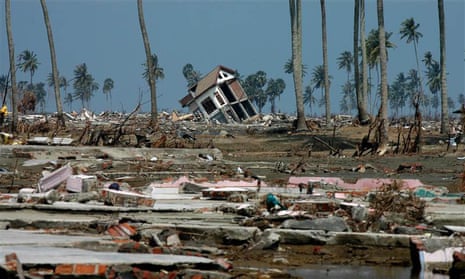The colossal scale of the Boxing Day tsunami – a 9.1 magnitude earthquake under the Indian Ocean displacing 30tn litres of seawater that hit the coasts of mainland Indonesia, Thailand, Sri Lanka and India in waves that rushed at 500mph – would compel even if it were not for the human catastrophe that accompanied its incomparably destructive force. A quarter of a million people were killed. Entire towns and communities were wiped out. Survivors’ stories are uniformly harrowing.
There have been a number of dramas – most notably the Abi Morgan-scripted miniseries Tsunami, the Aftermath in 2006 – but Channel 5’s three-part film, following the minute-by-minute progression of the tsunami from the moment the two tectonic plates 19 miles under the sea finally ruptured at 7.58am on 26 December 2004, is one of only a few documentaries about it. Dr Xand van Tulleken presents the main thrust of the story – travelling to the affected areas as he outlines the terrifying phenomenon’s journey and interviewing those who were caught up in it. Raksha Dave visits scientists who explain the facts behind the waves’ emergence, evolution and effects.
Van Tulleken, a doctor with experience of taking part in humanitarian missions, though not this particular one, is his usual personable self, but his trademark blend of expertise and compassion is overwhelmed by the Channel 5 documentary style. It is best described as requiring that the documentary style get in the way of the documentary at every conceivable stage. In his opening monologue, Van Tulleken noted that the tsunami “killed 250,000 people. Including … 149 Brits.” This evoked the satirical joke used in many comic settings – “A Briton suffered a minor injury during a hurricane in Brazil; 70,000 Brazilians were also killed” – and was a sign of the recurrent tone-deafness to come.
Everything in a not-good documentary must be dramatically headlined, often with exclamations that sound good but make no sense: “In order to understand it – we need to speak to those who witnessed it first-hand.” We must be told what we are going to be told, told it, then told what we have just been told. That goes not just for the entire show, but before and after every ad break too. Tsunami delivered every time. It is exhausting, dull and increasingly disrespectful to a story, especially to stories of loss, which require no emotive underscoring to ensure that everyone Gets It. There are points at which you can virtually hear the director whispering urgently to the cameraman/writer/music editor, “C’mon! I wanna hit ’em right in the feels!”
If you get past that, it’s a perfectly serviceable piece of work. The first episode covered the 98 minutes from the moment the earthquake happened (“Zero hour!”). Journalist Dendy Montgomery and his wife were living in Banda Aceh, Indonesia, which was hit first. “The walls were like rubber … the land is kind of like porridge,” he recalls. He and his wife went out with a camera and captured some of the little footage we have of the earthquake as it happened. Nevertheless, Raksha Dave is dutifully sent to an earthquake simulator at Southampton University to find out what a 9.1 magnitude quake feels like. Except the table she sits at is fixed to the floor for safety’s sake and they are only allowed to take the simulation up to seven on the scale, for 10 seconds. “Gosh,” she says afterwards. “I think there would be panic.” A triple whammy of pointlessness.
Luke Simon, his brother Piers and their friend Sophie were teaching and holidaying in Koh Phi Phi, Thailand, and found themselves caught in the first wave and scrambling to get up on to a roof as Sophie was hit by debris. The Chroston family were holidaying in Phuket, and Becca’s science-teacher father realised that the sight of the tide apparently going out meant a tidal wave was on its way. He didn’t, in fact, panic, but sent his family off to higher ground then ran down the beach warning others.
The next episode follows the tsunami’s journey to Sri Lanka – and the second wave that not even Becca’s dad knew was coming. There is no need for confected drama or any kind of simulation here.

Comments (…)
Sign in or create your Guardian account to join the discussion